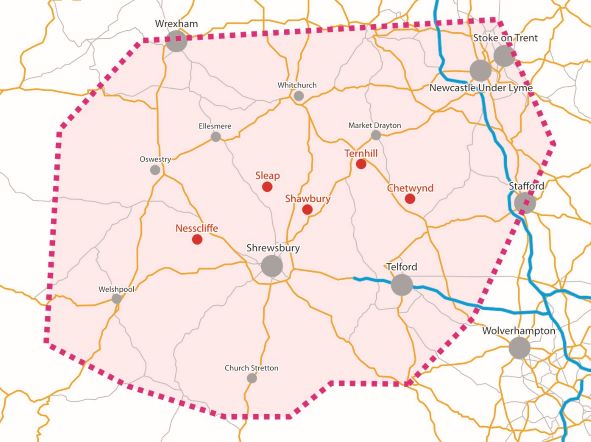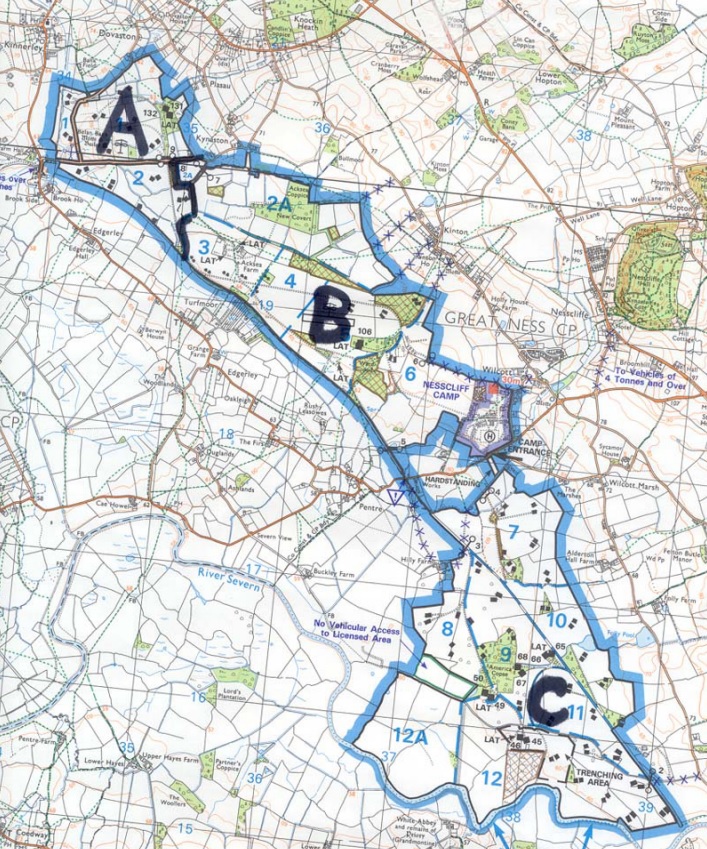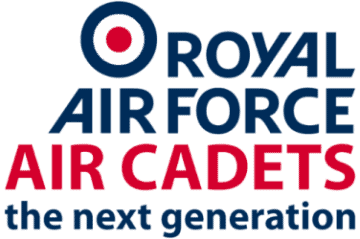Low flying
Low Flying Area 9 (LFA 9), covering all of Shropshire and the borders of adjacent counties, is a dedicated helicopter training area for military helicopters.

Intensive low-level helicopter activity, often down to ground level, takes place within the area between Monday to Friday, 0830 hours until 1730 hours with night flying occurring at periodic intervals. Detailed information on night flying can be viewed at the Night Flying Section of the website. Training does not normally take place at weekends or during Bank Holidays; however, extended hours or 24-hour flying may occur on any day of the week when operationally required.
More concentrated training activity occurs at RAF Shawbury and the Relief Landing Grounds of Tern Hill and Chetwynd airfield. Nesscliff Training Area is also used extensively for training and exercises.
Most of the helicopter training activity in Low Flying Area 9 is carried out by No.1 Flying Training School, which trains helicopter aircrew for frontline service in the Royal Navy, British Army and the Royal Air Force, and The Central Flying School (Helicopters), which trains the next generation of military helicopter instructors. Both schools are based at RAF Shawbury and operate Juno HT1 and the Jupiter HT1 helicopters. Juno and Jupiter helicopters from RAF Shawbury may also operate outside of Low Flying Area 9, in any part of the UK Military Low Flying System. Low Flying Area 9 may also be used for operational training and exercises by other military aircraft.
If you wish to find out more about military low flying, please visit: https://www.gov.uk/low-flying-in-your-area
Low Flying Complaints and Enquires
If you wish to make a complaint or enquire about low flying within Low Flying Area 9, covering all of Shropshire and the borders of adjacent counties, please use the following means of contact:
Email: [email protected]
Post: Low Flying Complaints and Enquires, RAF Shawbury, Shropshire, SY4 4DZ
Phone: 01939 251712
When making a complaint or enquiry, please provide the following information so that your complaint or enquiry can be looked into efficiently:
- Full name (title, first name and surname):
- Full postal address and postcode:
- Telephone number:
- Location of the problem (If different from postal address):
- Date and time of the problem:
- Aircraft description (colour, size, any identifying features/numbers):
- A brief description of your complaint/enquiry:
We aim to respond to all complaints and enquiries within 20 working days.
For low flying complaints and enquires outside of Low Flying Area 9, more information on how to make a complaint or an enquiry can be found at: https://www.gov.uk/low-flying-in-your-area/find-out-about-low-flying-in-your-area.
Night flying
This Page is updated on a regular basis and you may need to refresh your browser for the most up to date information.
The next period of Night Flying will commence on 25 March 2024 and will continue until 9 May 2024. Flying can normally be anticipated on Monday to Thursday evenings and we appreciate your tolerance of this essential training.
Helicopter crews can fly training sorties using Night Vision Devices throughout the whole of Low Flying Area 9 (LFA 9). Crews may use Nesscliff Training Area, Tern Hill and Chetwynd Airfield as part of their training, as well as practise circuits at RAF Shawbury.
Night Flying Times
Within the available hours of darkness night flying will begin, typically, at dusk and may occasionally continue until 2:30 am. We realise that night flying will, regrettably, cause some noise disturbance and therefore the amount of night training is kept to the minimum required to train our aircrew effectively. Information about military low flying can be found by visiting https://www.gov.uk/low-flying-in-your-area
Although every effort will be made to promulgate accurate information, the forecast night flying programme and times may be subject to short-notice changes owing to weather conditions, aircraft serviceability and other unforeseen factors. Helicopters from No. 1 Flying Training School (1 FTS) may use the Nesscliff Training Area, Chetwynd or Tern Hill airfield to conduct exercises including under-slung load training.
To complain or enquire about night flying, please see the Low Flying Complaints and Enquires section, within the Low Flying Information section.
Viewing area
There is no official viewing area for the safe viewing of aircraft at RAF Shawbury.
Nesscliff Operations
Nesscliff Training Area (NTA) is a military facility which is used extensively throughout the year by helicopters from RAF Shawbury for training pilots and rear crew. Much of the training activity will be undertaken by Juno helicopters of No. 1 Flying Training School (1 FTS) between 9am and 5pm (Monday to Friday) with night flying occurring at periodic intervals.
Owing to the flexible nature of the training programmes it is not possible to post detailed information on day-to-day activities as factors such as weather conditions, crew availability or aircraft serviceability are subject to change at short notice and, therefore, we could not guarantee its accuracy. Furthermore, the prevailing wind on the day will have a significant effect on the precise location selected for a particular exercise and the levels of noise generated.
A detailed map of Nesscliff Operating Areas

Area A - Confined Areas
Area B - Confined areas, sloping ground, general handling
Area C - Confined areas, sloping ground, general handling underslung loads
Because of the narrow shape of the NTA, helicopters will generally not be able to remain within its confines when conducting exercises involving flying a circuit pattern especially in a prevailing westerly wind. However, aircrew will endeavour to avoid overflying houses in the surrounding area and villages wherever possible.
Please note that military helicopters from other Service bases may also operate by day or night from the NTA for unspecified periods throughout the year.
Detailed information on helicopter night training be viewed at the night flying section
Safety Campaigns
RAF Shawbury High Visibility Campaign - Be Seen Be Safer
RAF Shawbury launched it’s 'Be Seen, Be Safer' horse rider awareness campaign in April 2015. The aim of the campaign is to promote the wearing of high visibility clothing by riders in Low Flying Area 9 so that they are more visible and can be seen earlier by the helicopter crew. Whilst high-visibility clothing may not prevent all over-flights as there may be other safety considerations, it does provide a considerable, cost-effective improvement to rider safety.
The task of Number 1 Flying Training School is to train military aircrew to be as professional and effective as possible. Low flying is an essential skill that all military helicopter aircrew must train in to reduce the risk to helicopters when operating in extremely demanding environments, whether these tasks are in support of peacekeeping, war-fighting or humanitarian relief. This essential training will usually take place in rural areas that are sometimes also used by horse riders. Flight trials run in 2003, in conjunction with the British Horse Society, demonstrated how effective high-visibility clothing is in enabling aircrew to see riders earlier and reduce the risk to them and their horses.”
RAF Shawbury’s campaign is also supported by the British Horse Society, who awarded the Tarquin Trophy to RAF Shawbury in 2015 for the “organisation which had made a significant contribution to equestrian safety.”
Alan Hiscox, Director of Safety at The BHS said “We are very pleased to have been working with RAF Shawbury for several years so that riders can understand the efforts that RAF pilots make to avoid flying over them. The wearing of high visibility clothing makes such a difference and increases the safety of every horse and rider.”
Officer Commanding Operations Wing at RAF Shawbury said: “I am very supportive of this campaign which makes a real difference to the safety of horse riders and carriage drivers in Low Flying Area 9. As part of the training syllabus, our instructors teach the trainees to consider riders and carriage drivers and if they can see them, they will do all that they can to avoid them if possible. I hope that riders will realise the benefits of wearing high viz and work with us to ensure that Low Flying Area 9 is as safe as possible for both riders and our aircrew.”
Squadron Leader Gary James, the Station Flight Safety Officer said: “With our helicopters travelling at speeds of up to 120 kts (130+ mph) at low level it can be very difficult to spot horse riders despite the very best lookout. This is because horses and dark coloured clothing tend to blend into the background. Against a wood line, a cropped field or a stone wall, for example, it can be almost impossible to see the rider until the aircraft is less than a few hundred metres away. By wearing an item of Hi-Viz while on horseback, the rider gives the pilot a far greater chance of seeing them”.
For more information contact:
Corporate Engagement and Relations Office
RAF Shawbury
Shrewsbury
SY4 4DZ
Email: [email protected]
Tel: 01939 250351 x7572
Download Be Seen Be Safer Poster
Download Be Seen Be Safer Leaflet
Thank you for your support, we have had significant support for the campaign for which we are very grateful. Unfortunately, this has meant that our high-visibility equipment is now out of stock and we are unable to fulfil any further orders. We hope to receive more high-visibility equipment in May 2024.
Drone Safety
Have You Spotted A Drone?
Please can we ask that if you see a drone flying in Low Flying Area 9 (Shropshire and borders of adjacent counties), that you kindly let us know? We hope that we will already be aware of it, but we would very much like to be informed twice than not at all for the safety of our crews. To notify us, please call RAF Shawbury Operations on 01939 250351 Extension 7163. In times when this number is unavailable, please use our Drone Notification Form
If you feel that the drone is being flown in such a way that could endanger an aircraft then please call both RAF Shawbury on 01939 250351 Ext 7163, if the sighting is in Shropshire or the surrounding areas, and then the Police on 101. Your assistance and vigilance are greatly appreciated.
Do You Fly a Drone?
Since the incidents at Gatwick and Heathrow Airports there have been several changes to the rules regarding the flying of drones. For the very latest information please go to the Civil Aviation Authority (CAA) page - Drone Code. You can also Download a leaflet on guidance to best practice when operating a drone within Low Flying Area 9 (Shropshire and borders of adjacent counties).
The biggest change is the establishment of Flight Restricted Zones (FRZs) and Runway Protection Zones (RPZs) around airfields both military and civilian. In short, it is illegal to fly a drone within these zones unless you have specific permission from that airfield. We have a number of drone operators who regularly fly within our zones because we have an excellent working relationship with them. They either fly their drones outside of our normal flying hours of 8:45am to 6:30pm Monday to Friday or, if they require to fly within these times and within the zones, they can request permission. Nearly all of the time we grant that permission as long as it does not affect our operations, or we can work around it. We positively encourage this communication as it works well for all concerned.
For an interactive version of all the zones within the UK, please go to - UK FRZ Map
The National Air Traffic Service (NATS) have also produced a free safety app called Drone Assist which is well worth downloading. The App along with others, can be found on the Apple App Store or Google Play Store.
Finally, we would kindly request that any drone operator intending to fly within Low Flying Area 9 (Shropshire and borders of adjacent counties), please inform us on 01939 250351 Extension 7163 so we can warn our crews. In times when this number is unavailable, please use our Drone Notification Form. We will only want basic information such as location, height and timings. It is not our intention to stifle your fun or hobby, we are simply trying to ensure that the skies above our beautiful county are as safe as possible for all.
Thank you in advance for your cooperation, we wish you all the very best with your drone flying.





